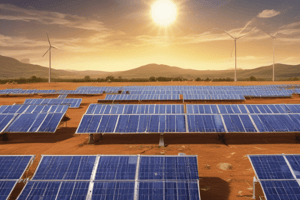Podcast
Questions and Answers
What is the most important design criterion for directly coupled photovoltaic systems?
What is the most important design criterion for directly coupled photovoltaic systems?
- Matching the load with the maximum power point of the array (correct)
- Increasing the size of the PV array
- Using battery storage for better performance
- Connecting the system to the electrical grid
Which type of stand-alone PV system has been increasing worldwide for supplying power to certain DC loads?
Which type of stand-alone PV system has been increasing worldwide for supplying power to certain DC loads?
- Wind turbine systems
- Directly coupled photovoltaic systems (correct)
- Grid-connected photovoltaic systems
- Hybrid photovoltaic and wind systems
What is the main purpose of battery storage in stand-alone photovoltaic DC systems?
What is the main purpose of battery storage in stand-alone photovoltaic DC systems?
- To provide power during nights or insufficient irradiance levels (correct)
- To increase the efficiency of PV arrays
- To replace the need for PV arrays
- To store excess solar radiation
Which applications commonly use directly coupled PV systems in remote areas of developing countries?
Which applications commonly use directly coupled PV systems in remote areas of developing countries?
What is the significance of matching the impedance of the DC load with the maximum power output of the PV array in directly coupled PV systems?
What is the significance of matching the impedance of the DC load with the maximum power output of the PV array in directly coupled PV systems?
What is the purpose of including a maximum power point tracking (MPPT) algorithm in the battery charger unit?
What is the purpose of including a maximum power point tracking (MPPT) algorithm in the battery charger unit?
Why is net metering preferred from a PV owner's perspective?
Why is net metering preferred from a PV owner's perspective?
What is the purpose of quickly and automatically dropping the PV system from the grid in the event of a utility power outage?
What is the purpose of quickly and automatically dropping the PV system from the grid in the event of a utility power outage?
Why might using two ratcheted meters be less preferred than net metering?
Why might using two ratcheted meters be less preferred than net metering?
What is the purpose of the power conditioning unit in a grid-connected PV system?
What is the purpose of the power conditioning unit in a grid-connected PV system?
Flashcards are hidden until you start studying
Study Notes
Design Criteria for Directly Coupled PV Systems
- The most important design criterion for directly coupled photovoltaic systems is to match the impedance of the DC load with the maximum power output of the PV array.
Stand-alone PV Systems
- The type of stand-alone PV system that has been increasing worldwide for supplying power to certain DC loads is the one that uses battery storage.
Battery Storage in Stand-alone PV Systems
- The main purpose of battery storage in stand-alone photovoltaic DC systems is to store excess energy generated by the PV array during the day for use during periods of low sunlight or at night.
Applications of Directly Coupled PV Systems
- Directly coupled PV systems are commonly used in remote areas of developing countries for applications such as water pumping, lighting, and telecommunications.
Importance of Impedance Matching
- Matching the impedance of the DC load with the maximum power output of the PV array is significant because it ensures maximum power transfer and efficiency in directly coupled PV systems.
Maximum Power Point Tracking (MPPT) Algorithm
- The purpose of including a maximum power point tracking (MPPT) algorithm in the battery charger unit is to optimize the energy harvested from the PV array by tracking the maximum power point of the array.
Net Metering
- Net metering is preferred from a PV owner's perspective because it allows them to sell excess energy back to the grid and offset their energy consumption.
Grid Disconnection
- The purpose of quickly and automatically dropping the PV system from the grid in the event of a utility power outage is to ensure safety and prevent the PV system from feeding back into the grid and causing damage or injury.
Net Metering vs. Two Ratcheted Meters
- Using two ratcheted meters is less preferred than net metering because it requires separate meters for energy consumption and production, which can be more complex and costly.
Power Conditioning Unit
- The purpose of the power conditioning unit in a grid-connected PV system is to convert the DC power generated by the PV array into AC power that matches the grid's voltage and frequency.
Studying That Suits You
Use AI to generate personalized quizzes and flashcards to suit your learning preferences.





